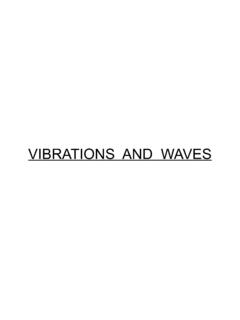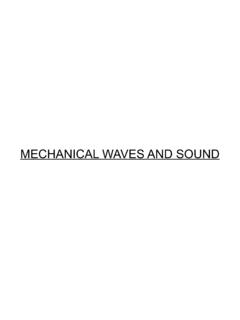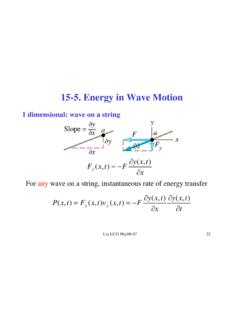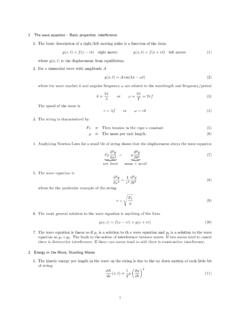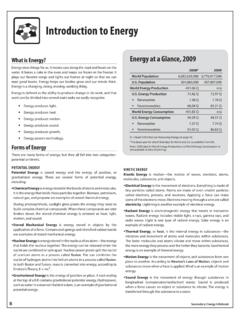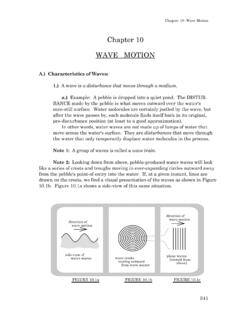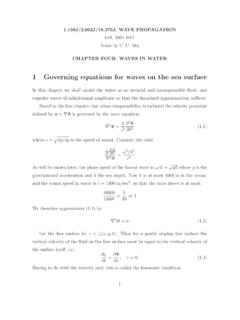Transcription of On the transport of energy in water waves - MIT
1 On The transport Of energy in water WavesMarshall P. TulinProfessor Emeritus, is developed and utilized for the calculation of the separate transport of kinetic, gravitypotential, and surface tension energies within sinusoidalsurface waves in water of arbitrary Section 1 it is shown that each of these three types of energy constituting the wave travel atdifferent speeds, and that the group velocity,cg, is the energy weighted average of these speeds,depth and time averaged in the case of the kinetic energy . It is shown that the time averagedkinetic energy travels at every depth horizontally either with (deep water ), or faster than the waveitself, and that the propagation of a sinusoidal wave is madepossible by the vertical transport ofkinetic energy to the free surface, where it provides the oscillating balance in surface energy justnecessary to allow the propagation of the wave.
2 The propagation speed along the surface of thegravity potential energy is null, while the surface tensionenergy travels forward along the wavesurface everywhere at twice the wave velocity, flux of kinetic energy when viewed traveling with a wave provides a pattern of steadyflux lines which originate and end on the free surface after making vertical excursions into thewave, even to the bottom, and these are calculated. The pictures produced in this way provideimmediate insight into the basic mechanisms of wave Section 2 the modulated gravity wave is considered in deepwater and the balance of termsinvolved in the propagation of the energy in the wave group isdetermined.
3 It is shown again thatvertical transport of kinetic energy to the surface is fundamental in allowing the propagation ofthe modulation, and in determining the well known speed of the modulation envelope, to Professor Newman in recollection of his many significant contributions to thetheory and computation of waves and floating bodies and to thefounding of the transport in waves has in the past been almost inextricably interwoven with the conceptof wave group velocity. The later arose from the very elemental observation of Scott Russell (1844),as quoted here in Lamb (1932, ): It has often been noticed that when an isolated group ofwaves, of sensibly the same length, is advancing over relatively deep water , the velocity of the groupas a whole is less than that of the individual waves composingit.
4 If attention be fixed on a particularwave, it is seen to advance through the group, gradually dying out as it approaches the front, whilstits former place in the group is occupied in succession by thewaves which have come forward fromthe sea. The first explanation of the group phenomenon in terms of the dispersive character of waterwaves was kinematical in nature, Stokes (1876), soon generalized by Rayleigh (1877a; 1877b) to avariety of waves in fluids, as well as to flexural waves in beams. The kinematical result, derived fromsuperposition of two dispersive waves of infinitesimally differing wave length, is that the group velocityis precisely the derivative of the frequency, , with respect to wave number,k.
5 Cg=d connection between the group velocity and energy flux wasmade by Osborne Reynolds (1877),who showed that the time averaged energy transported acrossany transverse plane in a train of deepwater linear waves is only half of the energy necessary to supply the waves which pass in the same1time, and this result was extended to water of arbitrary depth by Rayleigh (1877b, ), who alsoin the same paper provided a derivation alternative to Reynold s, and applicable to arbitrary derivation depended on the artifice of considering the wave number to have a small this time (1877), and leaving aside questions which arise in the non-linear wave regime, thestate of affairs regarding energy transport in waves has remained essentially as left by Rayleigh; forevidence of this see the masterly pedagogical discussions in Sir James Lighthill s (1978), Theory ofWaves.
6 The group velocity, subsequent to Rayleigh, made its appearance in the asymptotic analysis (sta-tionary phase) of water waves and its meaning and application were both extended to the treatmentof wave spectra, modulating waves , wave patterns (as the Kelvin ship wave), internal waves , andothers. In fact, its presence in wave theory is ubiquitous. There do remain questions however. Theunderlying connection between the separate kinematical and energy propagation origins of the groupvelocity remains obscure. Its meaning and definition in the non-linear regime of water waves offersdifficulties as well, see the discussion in Peregrine and Thomas (1979).
7 In the present paper we are concerned with more than the groupvelocity itself, particularly withsome very basic questions regarding the true nature of energy transport within the wave, and itsrelation to the mechanism of wave motion: (i) Do all components of the wave energy (kinetic, gravitypotential, and surface tension) travel at the group velocity,cg, uniform within the wave, and if not,how do they propagate? and (ii)What role do these transport speeds play in the mechanism of wavepropagation itself, both for the basic wave and for the modulation envelope?The surprising answers to these questions, already indicated in the Abstract above, may be foundwithin the context of the linear sinusoidal wave, and its second order counterpart in the case ofmodulating waves .
8 They allow us a more complete and satisfying physical understanding, in terms ofenergy transport , of the actual physical mechanism underlying the very existence of sinusoidal wavesand wave groups in general, including wave should be mentioned, for the sake of historical completeness, that the kinetic energy producedin the ideal fluid through the motion of a body was appreciatedby 19th c. theorists as central in thetreatment of the body s dynamics, and led to the concept of the added mass tensor for which formulaewere early produced, see Lamb (1932). Nevertheless, beyondthe calculation of the total field kineticenergy, important fundamental questions remain to this day: How does the energy flow from themoving body, parts of which must be doing work on the fluid, andthen penetrate into the fluid,permeating it and thus creating the flow field which connects through the fluid with the body?
9 Then,in what way does the fluid return energy to the body in other parts, making possible the existence ofbody motion without resistance in a perfect fluid?These questions, although beyond our present scope, can however be answered for planar bodiesusing certain fundamental relations introduced herein, aswell as the device of energy flux General Flux in a continuous mediaThe temporal change of a scalar quantity lies in the balance between its generation and thegradients of its flux, and can therefore always be written: e t+ ~Fe=Qe[ ]2where~Feis the flux ofeandQeits source, each defined locally in space and time.
10 When consideredwhile moving locally with the velocity~vR,dedt= e t+~vR e=Qe ~Fe+~vR eso that,dedt+ [~Fe ~vRe] =Qe e[ ~vR][ ]andthe effective flux and source are thus seen to depend on flux defined through [ ] and [ ] quantifies the transport of the scalar and thereby definesa transport velocity,~ce,~ce=~Fee ~vR[ ] Kinetic energy flux in an ideal fluidThe transport of the kinetic energy density ( q2/2 = ~u ~u), within an irrotational (~u= ),incompressible ( 2 = 0) flow is readily found. By definition,KE= q22= 2 ( )and taking into account incompressibility, a conservationlaw in the form of [ ] results.










